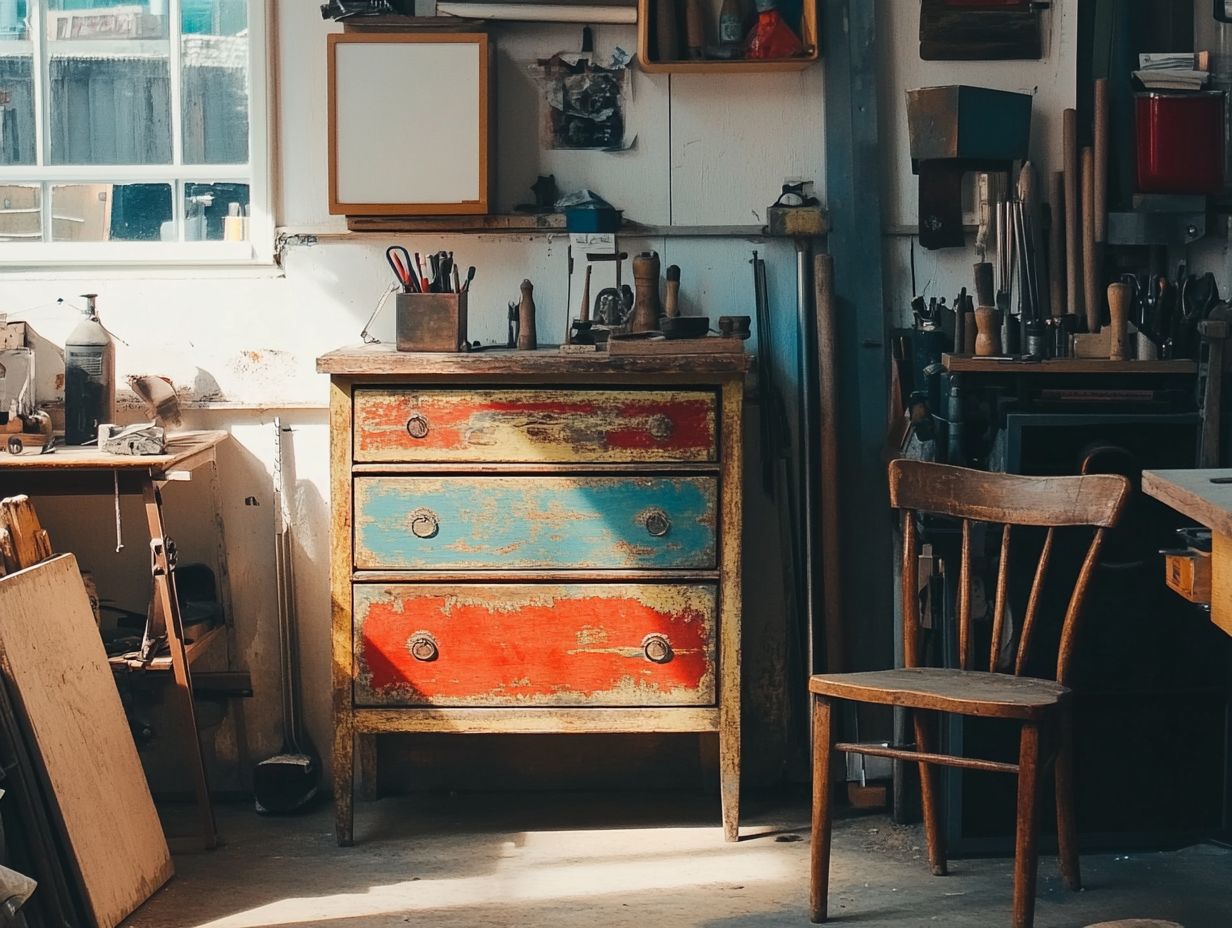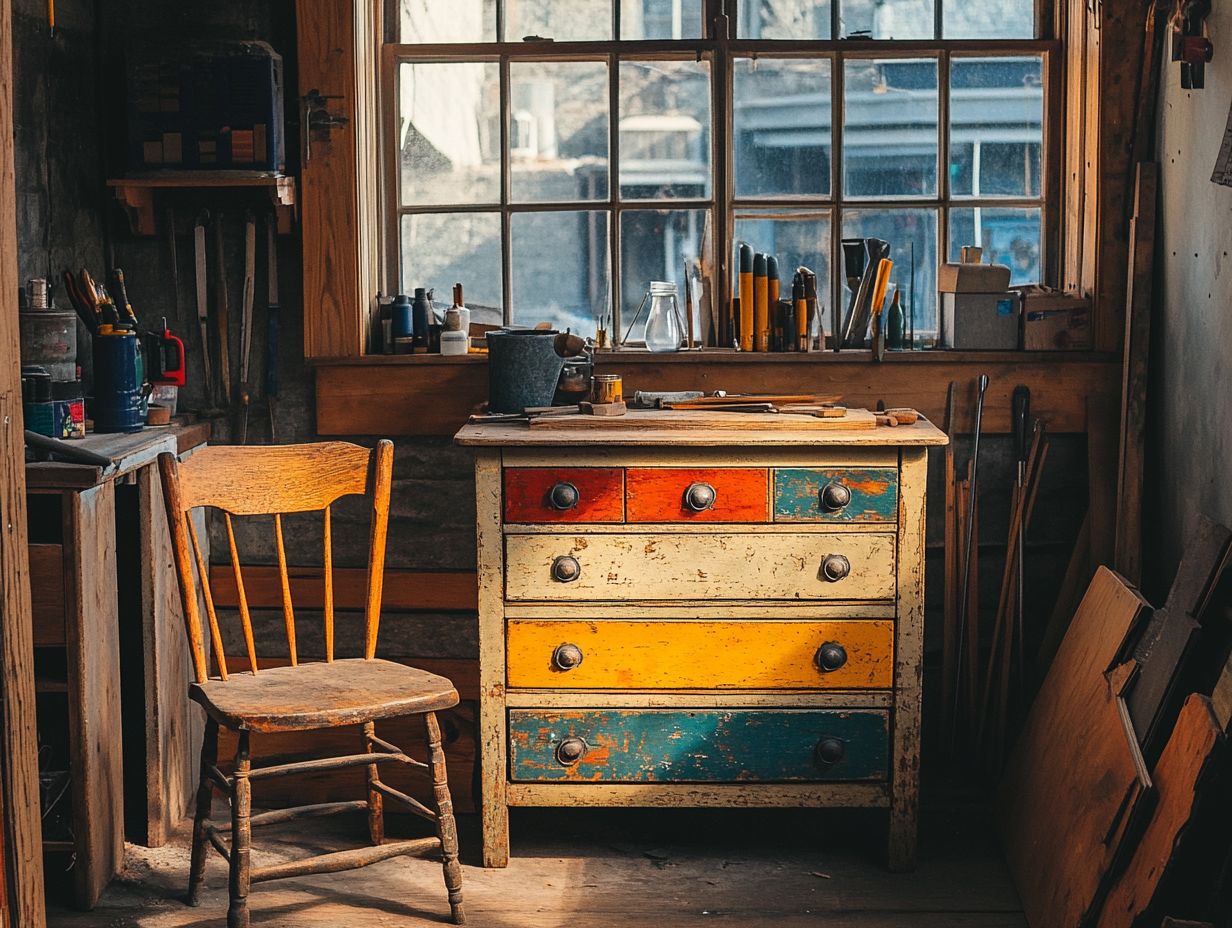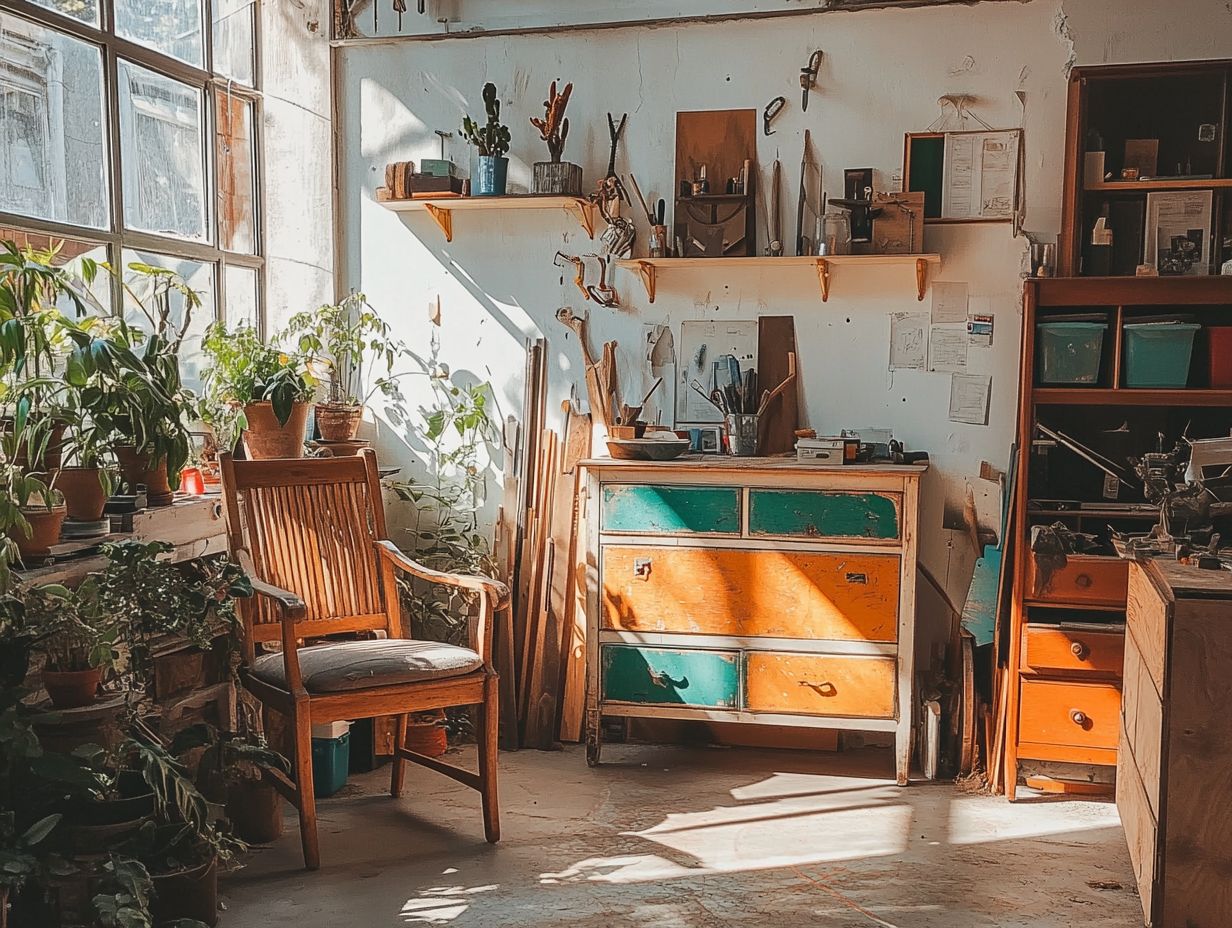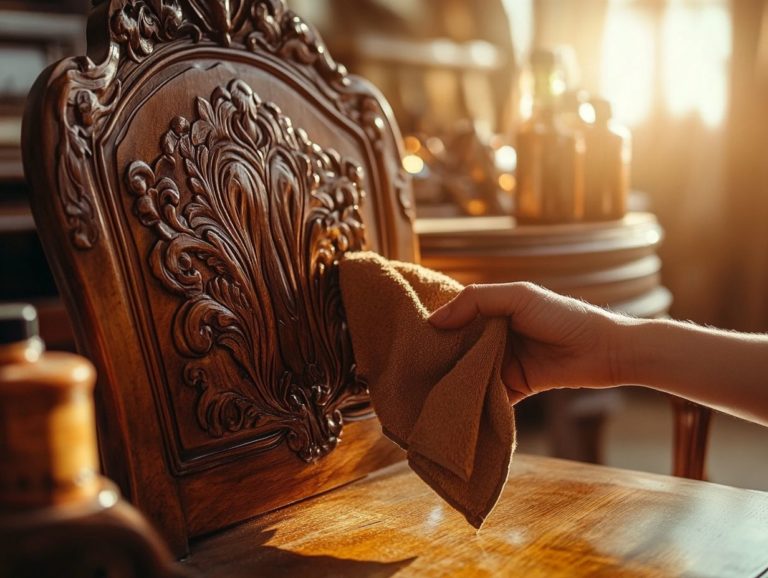5 Easy Ways to Upcycle Vintage Furniture
Upcycling vintage furniture offers you a remarkable opportunity to infuse new life into old pieces, all while adding a unique charm to your home.
Whether you re working with a beloved family heirloom or an intriguing thrift store find, the possibilities for transforming these items into functional art are virtually limitless.
Excited to dive in? You ll explore five effortless methods to revitalize vintage furniture, from repurposing it for a new use to applying a fresh coat of paint that breathes new energy into the piece.
Common inquiries regarding sourcing quality items, essential tools, and innovative ideas will be addressed, alongside a discussion of the environmental benefits of upcycling.
Contents
- Key Takeaways:
- 1. Repurpose Old Furniture for a New Use
- 2. Refinish and Paint for a Fresh Look
- 3. Add New Hardware or Accessories
- 4. Combine Different Pieces for a Unique Design
- 5. Use Vintage Furniture as Decorative Pieces
- What Are the Benefits of Upcycling Vintage Furniture?
- Frequently Asked Questions
- 1. What is upcycling and how does it differ from recycling?
- 2. Why should I upcycle vintage furniture instead of buying new?
- 3. What are some easy ways to upcycle vintage furniture?
- 4. Can I upcycle vintage furniture even if I’m not very crafty?
- 5. Is upcycling vintage furniture only for shabby chic or rustic styles?
- 6. Can I upcycle vintage furniture that is damaged or in poor condition?
Key Takeaways:

- Give old furniture a new purpose with upcycling, such as turning a dresser into a kitchen island.
- Refinishing and painting vintage furniture can give it a fresh, modern look while still preserving its unique character.
- Add new hardware or accessories to vintage furniture to update its style and functionality.
1. Repurpose Old Furniture for a New Use
Repurposing old furniture not only revitalizes your living space but also plays a crucial role in taking care of the environment by reducing furniture waste.
This creative endeavor invites you to see old pieces as opportunities for transformation, allowing you to craft unique furnishings that reflect your personal style.
With many DIY projects at your fingertips, each repurposed item becomes a canvas for your imagination. This sparks new ideas that make your home look great and help the Earth.
For example, picture transforming an old wooden door into a rustic coffee table or a charming headboard. Vintage suitcases could stylishly serve as nightstands or even cozy pet beds.
A simple coat rack might evolve into a decorative entryway shelf, showcasing your flair for creativity. These transformations celebrate your originality and cultivate a deeper appreciation for the history and narratives behind each piece.
The cultural significance of repurposed furniture is increasingly acknowledged in contemporary design. You can seek meaningful connections within your spaces, creating an aesthetic that beautifully merges nostalgia with modern functionality.
2. Refinish and Paint for a Fresh Look
Refinishing and painting old furniture can truly transform its appearance, offering a fresh look that harmonizes beautifully with your home decor.
To embark on this transformation, begin by carefully assessing the condition of the furniture. Ensure it is structurally sound and free from any significant damage.
The first step involves sanding the surface to create a smooth foundation, effectively removing old finishes and imperfections.
Once you’ve sanded it down, applying a primer will prepare the wood for painting, enhancing the adhesion of your chosen color.
For a stunning matte finish, consider using high-quality products like Annie Sloan chalk paint or Jolie Home paints. These options offer a rich array of colors and feature quick-dry properties for ease of application.
Popular DIY projects that embrace these refinishing techniques include chairs, dressers, and side tables, allowing you to customize each piece to reflect your individual style.
3. Add New Hardware or Accessories
Adding new hardware or accessories can truly elevate the aesthetic appeal of your furniture, transforming ordinary pieces into standout elements in your home decor.
By incorporating stylish knobs, elegant handles, or sturdy hinges, you can create a cohesive look that enhances the overall design.
Knobs in various shapes and colors can introduce a playful touch, while sleek handles lend a modern vibe. Unique hinges can add an unexpected twist to cabinet doors, turning them into focal points in any room.
If you’re on the hunt for these items, garage sales and thrift stores often hold hidden treasures, offering vintage styles that infuse character into updated pieces.
Online marketplaces expand your options, providing a vast array of choices that allow you to compare styles and prices effortlessly, ensuring that every selection perfectly complements your desired aesthetic.
What vintage treasures are you looking to upcycle? Share your ideas with us!
4. Combine Different Pieces for a Unique Design

Combining different furniture pieces opens up a world of unique design possibilities. This allows you to craft a harmonious space that reflects your personal style and highlights the beauty of furniture transformation.
By thoughtfully mixing styles like pairing a sleek mid-century modern chair with a rustic farmhouse table you can evoke a unique style that effortlessly draws the eye. Incorporating materials such as reclaimed wood alongside polished metal fixtures introduces a captivating contrast, showcasing the distinctive qualities of both elements.
For example, integrating vintage treasures like an ornate mirror or an antique trunk serves not just as functional decor but also as conversation starters. Each piece reflects the character of different eras, elevating your home decor and weaving a narrative that captivates anyone who steps into the room.
5. Use Vintage Furniture as Decorative Pieces
Vintage furniture serves not just as functional items but as striking decorative pieces that elevate the aesthetic of your home decor. It imbues each room with character and charm.
By thoughtfully placing these unique items throughout your space, you can achieve a captivating blend of old and new styles. For instance, imagine integrating a chic mid-century chair into your modern living room; the delightful contrast would be hard to miss. Similarly, a rustic farmhouse table can infuse warmth and nostalgia into a contemporary dining area.
The concept of restyling old furniture for new uses allows you to repurpose vintage pieces into stunning functional art. Picture transforming a weathered dresser into a trendy bathroom vanity or using vintage crates as unique shelving units. This approach not only showcases your individuality but also champions sustainability.
It s the perfect choice for anyone looking to infuse their home with creativity. Start your upcycling journey today!
What Are the Benefits of Upcycling Vintage Furniture?
The benefits of upcycling vintage furniture go far beyond just making your space look good. They also contribute to environmental protection, sustainable living, and the celebration of unique pieces that each tell a story.
By opting to upcycle instead of buying new, you can significantly cut down on furniture waste that often finds its way to landfills. This makes a notable difference in your ecological footprint.
This approach not only resonates with a sustainable lifestyle, but it also brings a variety of distinctive designs into your home decor. Repurposing vintage furniture allows you to showcase your personal style as each piece carries its own rich history and character.
Embracing these eco-friendly choices cultivates a sense of individuality, enabling you to create a home environment that mirrors your values and love for the planet while simultaneously celebrating artistry and craftsmanship.
How Can One Find Quality Vintage Furniture to Upcycle?
Finding quality vintage furniture to upcycle can be an incredibly rewarding pursuit. A wealth of resources are at your fingertips thrift stores, garage sales, and online platforms like Facebook Marketplace and Kaiyo are just the beginning.
To truly elevate this experience, consider honing your eye for craftsmanship and style. Familiarize yourself with various design styles, from Art Deco to Mid-Century Modern, and furniture types. This knowledge will serve you well as you sift through potential finds.
As you navigate the marketplace, approach negotiations with a clear budget and a friendly demeanor. Building rapport can often lead to more favorable deals, making the process not only more enjoyable but also more fruitful.
Evaluating the condition of each piece is essential. Look for sturdy construction, original hardware, and minimal wear; these signs indicate genuine vintage quality. For a more comprehensive understanding, consider referencing 5 essential pieces of vintage furniture. Prioritize materials like solid wood or metals over particle board, as they suggest longevity and promise a stunning transformation.
What Tools and Materials Are Needed for Upcycling?

To upcycle furniture successfully, gather essential tools and materials. These items streamline the transformation process and elevate the final aesthetic.
Having a variety of sanders is crucial for smoothing surfaces and removing old finishes. High-quality paint brushes help you apply paint evenly and prevent pesky streaks, leading to a professional-looking finish.
Depending on your project, different types of paint like chalk paint for an elegant matte finish or vibrant acrylic paint for a bold statement are key in achieving the distinct styles you desire.
Keep tools like screwdrivers, wood glue, and measuring tapes ready. They assist in repairs and adjustments, making your entire upcycling experience more efficient and enjoyable.
What Are Some Creative Ideas for Upcycling Vintage Furniture?
Exploring creative ideas for upcycling vintage furniture opens the door to innovative transformation projects that breathe new life into cherished pieces.
Imagine turning an old dresser into a striking TV stand that elegantly showcases your flat-screen television! Consider reimagining vintage suitcases as stylish storage options; these possibilities are boundless. For detailed instructions, check out this step-by-step guide to restoring vintage furniture.
You might even turn a worn-out wooden chair into a charming plant holder, inviting nature into your indoor spaces. A fresh coat of paint or clever decoupage techniques can dramatically elevate the aesthetic appeal of those well-loved items.
Ultimately, these approaches not only support sustainability but also empower you to express your unique style. Relish the satisfaction of crafting something truly one-of-a-kind.
How Can Upcycling Help the Environment?
Upcycling plays a crucial role in environmental protection by significantly reducing furniture waste and supporting sustainable living practices. It s a key element of eco-friendly home decor.
As discarded furniture accumulates in landfills, it contributes to increased greenhouse gas emissions and resource depletion, straining our planet’s ecosystems. Upcycling can cut landfill waste by up to 30%, turning unwanted items into unique pieces that carry their own stories.
The environmental benefits extend beyond waste reduction. The production of new furniture often involves harmful processes that pollute our air and water. By embracing upcycling, you support sustainable production methods and foster a circular economy, where materials are continually repurposed instead of tossed aside.
What Are Some Common Mistakes to Avoid When Upcycling Furniture?
When starting upcycling projects, avoiding common mistakes can elevate the success and quality of your furniture restoration efforts.
As an enthusiast eager to breathe new life into old pieces, it’s easy to overlook critical steps that ensure both durability and aesthetic appeal. Thorough preparation is essential cleaning surfaces and removing old finishes sets the stage for a stunning transformation.
Incorrect paint application, such as going too thick or skipping primer, can sabotage the final look. Use a spray technique or high-quality brushes for smoother results. Choose suitable materials, like environmentally friendly paints and stains. They enhance the final appearance and support sustainability.
By keeping these tips in mind, you can significantly improve both the process and the outcome of your upcycling journey.
Frequently Asked Questions

1. What is upcycling and how does it differ from recycling?
Upcycling turns your old, discarded items into fresh treasures! Unlike recycling, which breaks down materials, upcycling repurposes the item itself.
2. Why should I upcycle vintage furniture instead of buying new?
Upcycling vintage furniture is environmentally friendly. It adds character and uniqueness to your home.
Plus, you can save money by using materials you already have or by shopping for secondhand items.
3. What are some easy ways to upcycle vintage furniture?
Try painting or staining furniture, adding new hardware, or even using decorative paper to cover surfaces. These simple techniques can completely transform the look of old furniture.
You can also cover scratches with paint or use decorative paper to hide damaged areas.
4. Can I upcycle vintage furniture even if I’m not very crafty?
Yes, absolutely! Upcycling vintage furniture doesn’t require artistic talent or advanced crafting skills.
There are plenty of easy, beginner-friendly techniques anyone can do. Many tutorials and resources are available online to guide you through the process.
5. Is upcycling vintage furniture only for shabby chic or rustic styles?
No, not at all! While shabby chic and rustic styles are often associated with upcycled vintage furniture, you can create endless possibilities.
Upcycle furniture to fit any decor style, from modern and minimalistic to bohemian and eclectic.
6. Can I upcycle vintage furniture that is damaged or in poor condition?
Yes, you can still upcycle damaged or worn-out vintage furniture. In fact, it can be a great way to hide or fix imperfections.
Just make sure the furniture is still structurally sound and safe to upcycle.






